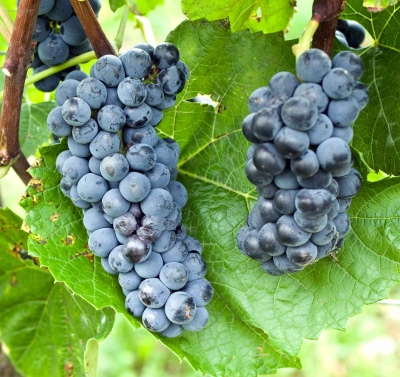
- Authors: R.M. Peterson (Brookings State University of South Dakota, USA)
- Appointment: universal
- Berry color: black
- Taste: labrus
- Ripening period: early
- Frost resistance, ° C: -46
- Name synonyms: SD7121, S.D.72S15
- Flower type: bisexual
- Density of the bunch: dense
- Appeared when crossing: Fredonia x S.D. 9-39 (V. riparia from northeast Montana)
The versatile grape variety Valiant, also known as SD7121, S. D. 72S15, has been successfully distributed worldwide for over 45 years. It is highly productive and productive, well suited for growing in dry climates. Its versatility makes Valiant a good choice for amateur winegrowers who use a variety of berry processing methods.
Breeding history
Valiant grapes bred in the United States, located in the University of South Dakota Brookings by breeder R. M. Peterson. Parent plants of the varieties Fredonia and S. D. 9-93 (V. riparia from northeastern Montana) were used for crossing. Crossing was first carried out back in 1967, but the SD7121 form was tested only 5 years later.
Description
Ripening period
Valiant is a mid-early grape variety. It reaches full maturity early, in the 3rd decade of August or in September, if the region does not have high average temperatures. The growing season is 128-138 days.
Bunches
The clusters of this grape variety are dense, small in size. Valiant forms clusters no more than 10 cm long. On 1 shoot, their number reaches from 3 to 5 pieces. The shape of the bunches is conical.
Berries
The Valiant grape bears fruit with small, well-rounded berries. The shade of the skin is black; when removed, it separates in the form of a bag. Weight of 1 berry varies from 1.8 to 3 grams.
Taste
The taste range is dominated by a labrus shade with notes of strawberries, rather sweet. The sugar content in berries is up to 200 g / dm3 with an acidity of 10 g / dm3. The pulp of the grapes is juicy.
Yield
The Valiant variety is distinguished by abundant fruiting. In fruitful years, you can harvest up to 6 kg from 1 m2 of vineyard area, the average figure is 3 kg / m2.


Growing features
The Valiant variety is well suited for growing in the climatic zones of the Moscow region, the North-West region. Here it easily takes root, provides fast rooting. The choice of a landing site should be made in favor of a well-lit area protected from the wind. The variety is undemanding to the type of soil.
Landing
You can move seedlings to open ground both in spring and in autumn. 24 hours before the transfer, it is necessary to send the cuttings with the formed roots into the water so that they are saturated with moisture. The pit for Valiant grapes should have a depth of 60 cm and dimensions of 700 × 800 mm.A soil substrate is poured into the center of the depression, a support is placed that will support the growing vine. The seedling is placed on this hill, the roots are straightened, and covered with earth.
A small distance can be left between the bushes, about 0.5 m from the edges of the holes. It is recommended to mulch the near-stem area.

Pollination
Male and female flowers are formed on the vines. Additional pollination is not required. Suitable plants can be planted nearby to increase productivity.
Pruning
In order for the vine to provide abundant fruiting, the bush is pruned. In the spring, dried and dead shoots are removed. At the end of summer, the vines are shortened by 30 cm, the leaves that have changed color are removed. Pruning correctly will help ensure more efficient ripening of the berries.

Watering
The first watering is carried out immediately after planting, on the soil compacted in the near-trunk zone. 1 hole requires 4 buckets of water with a temperature of +20.25 degrees. The rest of the time, moisture is added to the dried soil. In the rainy season, additional drainage is required, otherwise the roots of the grapes can rot. Watering volumes are normally up to 40 liters per bush per month. In dry climates, a drip irrigation system is a good solution.


Top dressing
It is recommended to fertilize Valiant grapes regularly, at least 3 times per season. Such measures will enhance the immune defense of plants, increase the intensity of their growth. In spring, after the snow melts, it is recommended to apply mineral fertilizers to the soil. In the summer months, potassium-phosphorus combinations are used to improve fruit ripening. Feeding with organic matter is shown to the plant before wintering - during this period, humus and manure, diluted with water, give especially good results.
Frost resistance and the need for shelter
The variety is very frost-resistant, does not need shelter. Withstands a drop in atmospheric temperatures down to -46 degrees. Due to its high winter hardiness, the variety is widespread in the northern regions of the Russian Federation.

Diseases and pests
Valiant is susceptible to mildew attack. In humid climates, bushes are also susceptible to the development of other fungal diseases. Preventive treatment is required, regular inspection of leaves and vines. You also have to protect the bushes from powdery mildew. Plants are shown spraying with fungicides, copper sulfate, colloidal sulfur.

If a grape is exposed to any disease or insect, this always affects its appearance.
Storage
The variety lends itself well to storage. Valiant grapes tolerate transportation well. At a temperature not higher than +5 degrees and humidity above 85%, it can be stored from 3 to 6 months.











































































